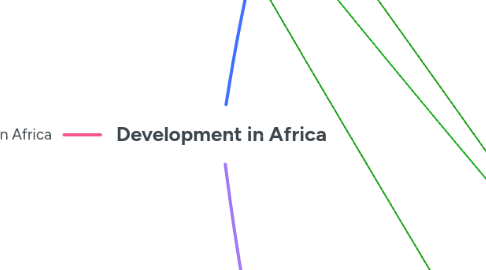
1. Sub-Saharan Africa
1.1. Cultural
1.1.1. playing music
1.1.2. visual arts
1.1.3. telling stories
1.1.3.1. Griosts and Griottes
1.1.3.1.1. men served as griots
1.1.3.1.2. women served as griottes
1.1.4. Originally: Bantu speaking people
1.1.4.1. After: Bantu-Arabic mixing: Swahilli city state
1.1.5. Religious Diversity
1.1.5.1. 1. Animism
1.1.5.2. 2. Christianity
1.1.5.3. 3. Islam
1.2. Social
1.2.1. Small communities organized
1.2.1.1. Kinship
1.2.1.1.1. Chief: Male head of the network
1.2.2. Labor system
1.2.2.1. age
1.2.2.1.1. significant social marker
1.2.2.2. gender
1.2.2.2.1. influential role in social organization
1.2.3. Slavery
1.2.3.1. owning a large number of enslaved people increase one's social status since people could not own land privately
1.2.3.1.1. Zanj rebellion in East Africa
1.2.3.2. Kinds of slavery
1.2.3.2.1. 1. Chattel slavery
1.2.3.2.2. 2. Domestic
1.2.3.2.3. 3. Debt Bondage
1.3. Economic
1.3.1. Indian Ocean Trade
1.3.1.1. Coastal city
1.3.1.2. Exchange spices with gold
1.3.1.3. Slave trade between East Africa and the Middle East
1.3.2. Tran-Saharan Trade
1.3.2.1. West to East: Gold and ivory
1.3.2.2. East to West: Salt,East copper, cloth, and tools
1.4. Political
1.4.1. Before: Decentralized
1.4.1.1. No centralized government. They established communities based on kinship.
1.4.2. After: More central governments were established
1.4.2.1. Survival for small kin-based communities became challenging.
2. West Africa
2.1. Huasa Kingdoms
2.1.1. Decentralized city states
2.1.1.1. Constant warfare
2.1.1.2. Connected by kinship
2.1.1.2.1. Ruled by chief (A male leader)
2.1.2. Strong trading relationship
2.1.2.1. Trade with speciality between city states
2.1.2.2. Trade with outsider by Tran-Saharan trade
2.1.2.2.1. They were venerable to outsiders because of lack of centralized power.
2.1.3. Islam
2.1.3.1. Brought by missionaries from other region in 14th century.
2.2. Ghana
2.2.1. Centralized government
2.2.1.1. Nobles and armies
2.2.1.1.1. Use of Iron
2.2.1.2. Capital: Koumbi Saleh
2.2.2. Strong trading relationship
2.2.2.1. Trade with Muslims by Tran-Saharan trade
2.2.2.1.1. West to east: gold and ivory East to west: salt, copper, cloth, and tools
2.2.3. Islam
2.2.3.1. Conversion to Islam because of trading relationship and pressure from northern Muslim
2.2.3.2. Akan----Christianity----Islam
2.3. Mali
2.3.1. Islam
2.3.1.1. Founder: Sundiata, a Muslim
2.3.2. Strong trading relationship
2.3.2.1. Trade with North African and Arab merchants
2.3.2.2. Dominance of gold resources
2.3.2.3. Mansa Musa: pilgrimage to Mecca
2.3.3. Visitors
2.3.3.1. Ibn Battuta. He had accounts of these strong Islamic culture
3. East Africa
3.1. Zimbabwe
3.1.1. Agriculture
3.1.2. Capital
3.1.2.1. Great Zimbabwe
3.1.2.1.1. A large stone wall
3.1.2.1.2. Decline: overgrazing, which damaged the surrounding environment
3.1.3. Grazing
3.1.4. Strong trading relationship
3.1.4.1. Indian Ocean trade
3.1.4.1.1. Trade with coastal city-states
3.1.5. Strong architecture
3.1.5.1. Construct their houses(zimbabwes) by stone from 9th century.
3.2. Ethiopia
3.2.1. Religious diversity
3.2.1.1. Islam
3.2.1.2. Christianity developed independently
3.2.1.2.1. A Christian led kingdom in Ethiopia
3.2.2. Strong trading relationship
3.2.2.1. Indian Ocean trade
3.2.2.2. Trade with Roman Empire
3.2.3. Expressed their power through architecture
3.2.3.1. 11 massive churches
3.2.3.1.1. Churches made of rock. Carved rock structures had been a feature of Ethiopian religious architecture.
3.3. Indian Ocean slave trade
3.3.1. enslaved East Africans(zanj)
3.3.1.1. Zanj Rebellion
